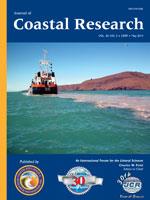Sousa, S.H.M.; Amaral, P.G.C.; Martins, V.; Figueira, R.C.L.; Siegle, E.; Ferreira, P.A.L.; Silva, I.S.; Shinagawa, E.; Salaroli, A.; Schettini, C.A.F.; Santa-Cruz, J., and Mahiques, M.M., 2014. Environmental evolution of the Caravelas Estuary (northeastern Brazilian coast, 17° S, 39° W) based on multiple proxies in a sedimentary record of the last century,
A sediment core (∼100 cm long) taken from the upper Caravelas estuary was interpreted based on sedimentological, microfaunal, geochemical, and historical data for the last 70 years. Outcomes are a significant contribution to the understanding of the relationship between anthropogenic impact and natural ecosystem change. The results obtained for the period between the 1930s and the beginning of the 1970s do not reveal any evidence of natural and/or anthropogenic impacts in the estuary. This period is characterized by a higher percentage of sandy sediments, lower pollution load index (PLI) values, and a mixed source of organic matter (C3 land plants and marine dissolved organic carbon [DOC]). During the period from the 1970s to the 1990s, widening of the inlet and the entrance of marine water initiated a rapid natural environmental transformation of the area, increasing the amount of mud and producing an abundance of open marine–dwelling ocean foraminifera species, including Pararotalia cananeiaensis, and a decrease of foraminifera density and diversity values. The slight increase of PLI values and the predominance of C3 land plant organic matter observed in this period might be the result of anthropogenic activities related to the soil occupation in the area, which are also reflected in the abundance of Ammonia tepida. During the last decade, dredging operations close to the inlet channel may have contributed to increased transport and deposition of marine sediments into the estuary.





